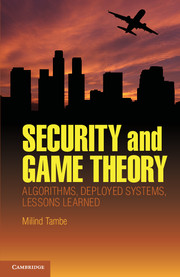Book contents
- Frontmatter
- Contents
- Acknowledgments
- 1 Introduction and Overview of Security Games
- PART I SECURITY EXPERTS' PERSPECTIVES
- PART II DEPLOYED APPLICATIONS
- 4 Deployed ARMOR Protection: The Application of a Game-Theoretic Model for Security at the Los Angeles International Airport
- 5 IRIS – A Tool for Strategic Security Allocation in Transportation Networks
- 6 GUARDS: Game-Theoretic Security Allocation on a National Scale
- PART III EFFICIENT ALGORITHMS FOR MASSIVE SECURITY GAMES
- PART IV FUTURE RESEARCH
- PART V SHORT BIOS
- References
- Index
- References
6 - GUARDS: Game-Theoretic Security Allocation on a National Scale
from PART II - DEPLOYED APPLICATIONS
Published online by Cambridge University Press: 05 January 2012
- Frontmatter
- Contents
- Acknowledgments
- 1 Introduction and Overview of Security Games
- PART I SECURITY EXPERTS' PERSPECTIVES
- PART II DEPLOYED APPLICATIONS
- 4 Deployed ARMOR Protection: The Application of a Game-Theoretic Model for Security at the Los Angeles International Airport
- 5 IRIS – A Tool for Strategic Security Allocation in Transportation Networks
- 6 GUARDS: Game-Theoretic Security Allocation on a National Scale
- PART III EFFICIENT ALGORITHMS FOR MASSIVE SECURITY GAMES
- PART IV FUTURE RESEARCH
- PART V SHORT BIOS
- References
- Index
- References
Summary
Introduction
The United States Transportation Security Administration (TSA) is tasked with protecting the nation's transportation systems. These systems are often large in scale and protecting them requires many personnel and security activities. One set of systems in particular is the over 400 airports. These airports serve approximately 28,000 commercial flights per day and up to approximately 87,000 total flights [Air Traffic Control]. To protect this large transportation network, the TSA employs approximately 48,000 Transportation Security Officers (TSA); who are responsible for implementing security activities at each.
Many people are aware of the common security activities, especially individual passenger screening. However, this is just one of many security layers TSA personnel implement to help prevent potential threats (TSA). These layers can involve hundreds of heterogeneous security activities executed by limited TSA personnel, leading to a complex resource-allocation challenge. Unfortunately, TSA cannot possibly run every security activity all the time and thus must decide how to appropriately allocate its resources among the layers of security activities.
To aid the TSA in scheduling resources in a risk-based manner, we take a multi-agent game-theoretic approach. Motivated by advantages of such an approach reported at AAMAS conferences (see Section 6.2.2), we utilize Stackelberg games, in which one agent (the leader) must commit to some strategy first and a second agent (the follower) can make his decision with knowledge of this commitment. Here, the TSA acts as a defender (i.e., the leader) who has a set of targets to protect, a number of security activities they can utilize to protect each target, and a limited number of resources to assign to these security activities.
- Type
- Chapter
- Information
- Security and Game TheoryAlgorithms, Deployed Systems, Lessons Learned, pp. 107 - 128Publisher: Cambridge University PressPrint publication year: 2011
References
- 34
- Cited by



